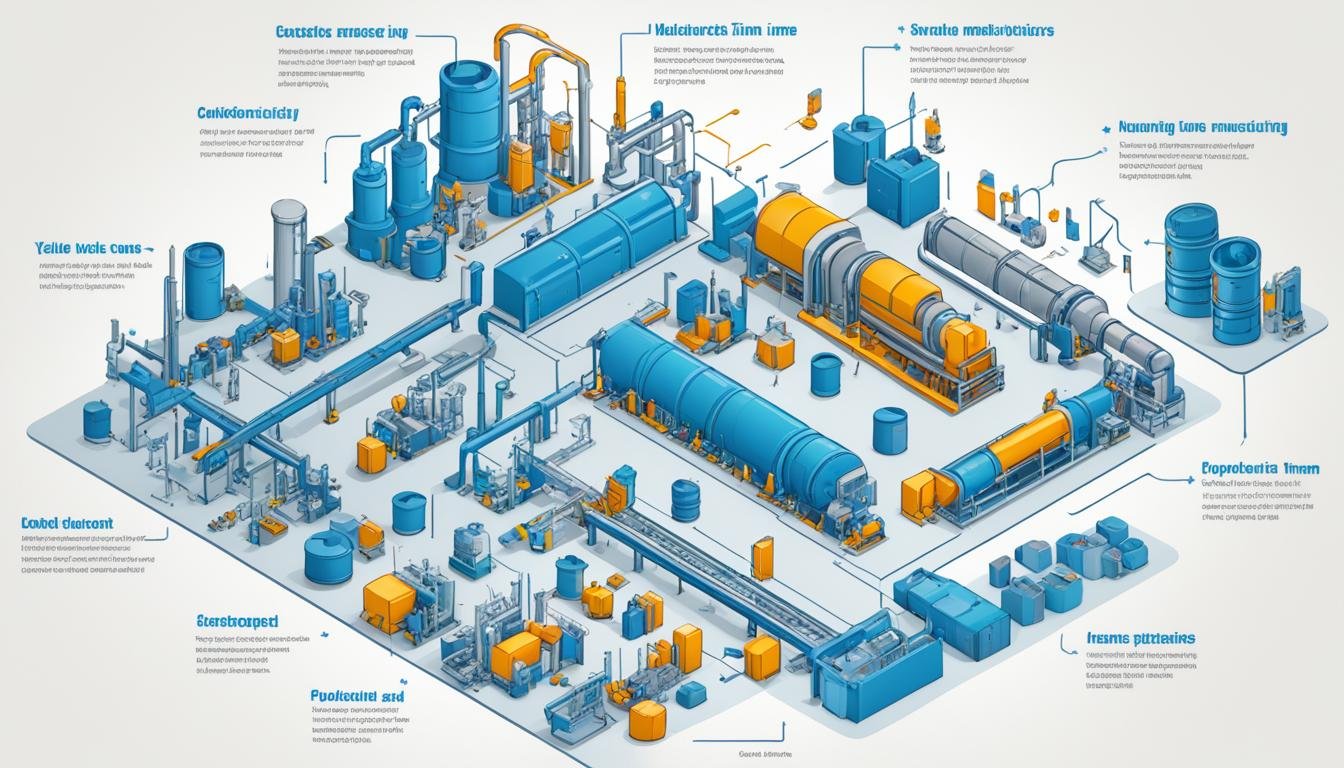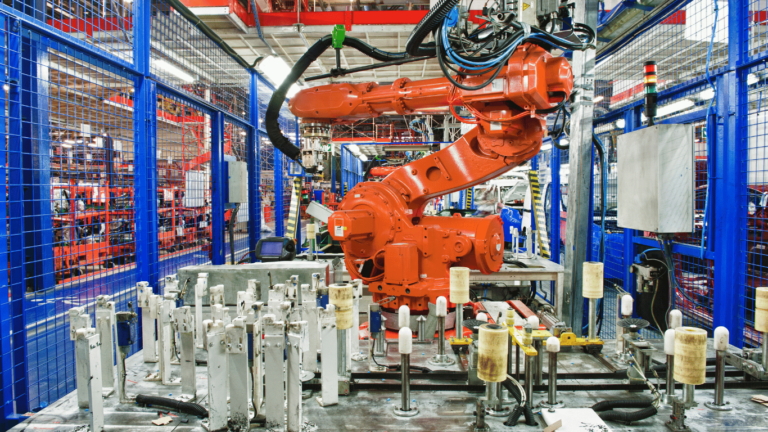Value Stream Mapping for Manufacturing Efficiency
Did you know that using Value Stream Mapping (VSM) can boost efficiency by up to 40%? This powerful method is changing the game in lean manufacturing. It gives companies a clear way to improve their production steps from the beginning to the end.
VSM cuts down on extra transport, reduces waiting times, and stops overprocessing. It focuses on what really adds value for customers and makes sure it’s done right the first time. By looking at the whole flow of goods and info, VSM is more than just a simple map. It’s a key strategy for process optimization.
VSM is all about cutting waste and improving quality. It helps make operations more efficient and helps manage costs better. It’s a must-have for manufacturers who want to see their whole workflow and find ways to get better.
As companies look to use lean manufacturing more, adding value stream mapping to their methods is becoming crucial.
Key Takeaways
- Value Stream Mapping can boost efficiency by up to 40% in manufacturing.
- Focuses on value-adding activities and eliminating non-value-added activities.
- Essential for visual management and process optimization in lean manufacturing.
- Helps identify waste and redesign workflows for better quality and reduced costs.
- VSM integrates the entire flow of information and material handling.
Understanding Value Stream Team Mapping in Lean Manufacturing
Value Stream Mapping for Manufacturing Efficiency is a key technique in lean principles. It makes it easier to see and manage the flow of materials and information needed to deliver products to customers. This method goes beyond simple flowcharts by adding important details. These details help improve visibility and control.
What is Value Stream Mapping?
Value Stream Mapping (VSM) is a tool used in lean manufacturing. It maps and analyzes the flow of materials and information in production. It comes from the Toyota Production System and helps spot waste and areas for improvement. This leads to making production smoother.
- Process Map: Visual representation of all manufacturing steps
- Timeline: Metrics for lead time, cycle time, and inventory
- Information Flow: Details on the information exchange between stages
Purpose and Importance of VSM
The main goal of Value Stream Mapping is to make manufacturing more efficient by cutting waste. A study by PwC found that 80-90% of tasks in business don’t add value for customers. They are seen as wasteful.
VSM is vital because it gives a full view of the production flow. It shows the flow of materials and information, going beyond just the steps. This helps everyone from top management to production staff work together for better efficiency and improvement.
Core Components of a Value Stream Map
Value Stream Maps have key parts:
- Process Data Boxes: Include metrics such as cycle time, uptime, downtime, availability, and quality percentages.
- Current State Map: An initial map showing the current process flow. It starts with the team’s understanding of the flow from start to finish.
- Future State Map: A design of the optimized process, eliminating inefficiencies.
Process data boxes in VSM track detailed metrics like cycle time, downtime, uptime, availability, and more. These help create a shared language for talking about and improving processes. For example, a rope manufacturing company used VSM to save six and a half minutes per order. This cut down on 33% of material handling time.
Using VSM with kaizen—continuous improvement—lets for ongoing process refinement. This leads to efficiency gains across the manufacturing world.
Steps to Implementing Value Stream Mapping
Implementing Value Stream Mapping (VSM) means changing how we make things. It follows a seven-step plan to cut waste and keep improving. Here are the key steps to start with VSM:
Documenting the Current Process
The first step is to write down how things work now. We list all steps, find delays, and see where inventory and inefficiencies are. This helps us make smart choices by showing us what’s really happening.
Identifying Customer Value
Then, we figure out what makes the customer happy. We look at every step to see what really adds value. This helps us focus on making things better for the customer.
Defining the Perfect Process
Next, we dream up a process without waste. We imagine a workflow that’s efficient and meets customer needs. This phase is all about making things better and more flexible.
Pinpointing Process Inefficiencies
Now, we find where things slow down or get stuck. By using what we’ve learned, we can fix these problems. This makes our processes smoother.
Creating the Ideal Future State Map
The last step is to draw a map of the perfect future. It shows how we want things to flow smoothly, following lean principles. This map helps us make real changes for better efficiency.
By following these steps, companies can make smart choices, reduce waste, and always get better. Knowing where we are and where we want to go helps us improve our manufacturing.
Benefits of Value Stream Mapping for Manufacturing Efficiency
Value Stream Mapping (VSM) boosts manufacturing efficiency by using lean manufacturing ideas. It makes workflows better and encourages ongoing improvement in manufacturing settings.
Process Optimization
VSM helps optimize processes. It shows the whole production flow, letting manufacturers spot and remove bottlenecks and waste. This leads to smoother operations. VSM lets companies use lean methods to improve how they handle information and materials, making them more efficient.
Waste Reduction
VSM is great for cutting waste. It pinpoints processes that use resources but don’t add value, letting companies get rid of these inefficiencies. Cutting waste saves money and makes better use of resources, boosting productivity. About 80-90% of business activities might be wasteful, showing how important it is to spot and reduce waste with VSM.
Continuous Improvement
VSM also promotes a culture of ongoing improvement. By regularly reviewing and updating processes, companies stay flexible and ready for new demands. This steady push for betterment embeds lean manufacturing ideas in the company, leading to lasting efficiency gains. VSM helps keep up this improvement by offering a clear way to check and review processes.
Lead Time Reduction
Lastly, VSM is key to reducing lead times, improving delivery schedules, and making customers happier. By mapping out the whole process, from start to finish, companies can see how to make things faster and more reliable. This shortens lead times and makes production more predictable. Using VSM can cut costs by reducing unplanned downtime and matching production with what customers need.
Adding VSM to manufacturing can lead to more efficiency, proving its worth as a key lean manufacturing tool.
Real-world Applications and Case Studies
Value Stream Mapping (VSM) shows its value in many real-world examples. For example, a rope maker changed their production area with VSM and cut down on moving materials. This change made their work more efficient and productive.
Toyota used VSM to cut waste in their making process. They used methods like the Toyota Production System (TPS), jidoka, kaizen, and Just-in-time (JIT) production. This helped them stay ahead in the market.
At FedEx Express in LAX, a lean team boosted C-checks from 14 to 30 a year. They cut down the time needed for a C-check from 32,715 to 21,535 hours. This shows how VSM can make work more efficient and use labor better.
In tech, a big IT company used VSM to improve how they delivered services. This made communication and teamwork better among leaders. It also made customers happier, showing how VSM helps in improving service industries.
Nike used JIT production and the Manufacturing Index in 2011 to reduce waste and make things more consistent. By always improving and engaging employees, Nike cut costs and got more efficient.
In healthcare, VSM has also been very useful. A study showed it helped reduce wait times and improve patient care by fixing process problems. This shows VSM can help in many areas, not just making things.
These examples from different fields show how powerful VSM is. It helps companies see where they can improve and make things more efficient. As companies face more competition, VSM is key for staying ahead.
Conclusion
Value Stream Mapping is a key tool for companies wanting to stay ahead in today’s fast-paced market. It simplifies complex processes, helping manufacturers cut waste and boost efficiency. This method focuses on adding value for customers and making processes clear.
Many companies have seen the benefits of using VSM for better manufacturing efficiency. By identifying what adds value and what doesn’t, they can focus on what really matters. This leads to faster production times, less downtime, and better quality products.
Numbers play a big part in VSM. Things like takt time, setup time, and how long things wait show where improvements are needed. Seeing the cost savings and progress in making things better motivates teams to keep improving.
Using lean principles with VSM gives companies a strong plan for success. It helps them cut waste and keep improving. By making things simpler and focusing on what customers want, companies can make big strides in efficiency and quality.
Source Links
- What is value stream mapping (VSM) in lean manufacturing: definition and application
- Value Stream Mapping | Atlassian
- Value Stream Mapping: The Search for Adding Value and Eliminating Waste
- Understanding the Fundamentals of Value-Stream Mapping – Lean Enterprise Institute
- What is Value Stream Mapping (VSM) in Lean Manufacturing?
- Value Stream Mapping: 4 Steps to Get Started with VSM
- Value Stream Mapping (VSM): 6 Steps to Improve Sales & Operations
- Value Stream Mapping: Process and Benefits
- Why Do Value Stream Mapping? | Benefits & Examples
- Revolutionizing Efficiency: Exploring Lean Manufacturing Value Stream Mapping
- 9 real-life Lean Manufacturing examples
- Value Stream Mapping Examples for Different Industries | MOSIMTEC
- Unleashing Efficiency: The Power of Value Stream Mapping in Modern Business
- Value Stream Mapping: Unlocking Efficiency
- Value Stream Mapping: Your Super Power to Streamlined Processes







